Twelve Days that Opened a Door from Tohoku to Asia
Yuichi Tomohiro (Representative TUMUGIYA/Resource Coordinator)
The Japan Foundation carried out a "designer-in-residence" program titled "DOOR to ASIA" in and around Rikuzentakata City on the Sanriku Coast from December 1 through 12, 2015, with the participation of seven young designers invited from ASEAN member countries. The participants in the program explored the themes "designs that contributes to local communities" and "the role of designers in the event of natural disasters" in the context of "regional creation" and "natural disasters," two issues that are shared by all Asian countries. There, the participants cooperated with entrepreneurs from the area and created designs that used local materials. Yuichi Tomohiro of TUMUGIYA, who was involved in the implementation of this project and accompanied the participants during the program, contributed this article about the project and its outcomes.
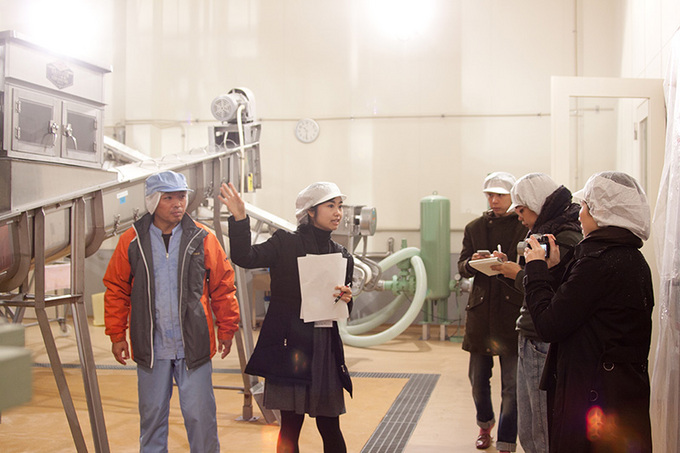
Designers earnestly listen to an explanation about the soy sauce manufacturing process at Yagisawa Shoten
"Had I listened to this in a private room, I might have cried."
These words spoken by an entrepreneur after the local briefing session vividly illustrate the outcomes of the ten days the participants spent in Rikuzentakata City as the hub of their activities. This is how extremely active and intensive these days were for the participants, who worked together inspired by a strong respect for each other while trying to deepen their mutual understanding.
Seven up-and-coming young designers from five ASEAN member countries (Thailand, the Philippines, Malaysia, Singapore, and Indonesia) came to Japan to participate in the program. They were joined by Japanese designers and people working in the field of design. The participants spent the first and last day of the program in Tokyo, where they visited facilities and observed various case studies. They spent the ten days in-between at Hakoneyama Terrace, an accommodation facility in Rikuzentakata City that was completed after the Great East Japan Earthquake of 2011. The striking design of its terrace creates the sensation of floating above the surrounding mountains.
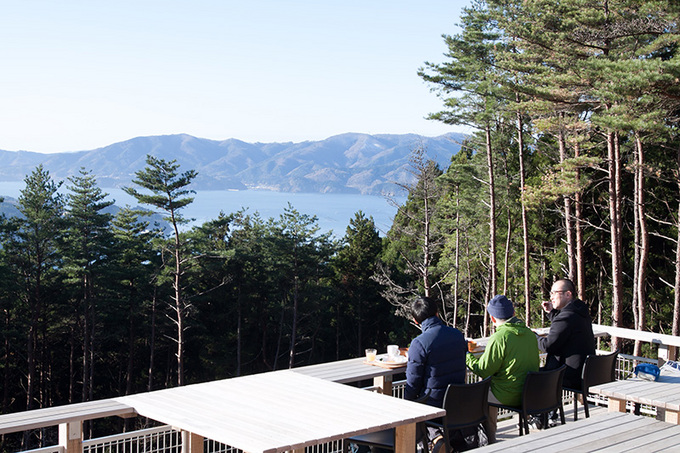
Hakoneyama Terrace in the program's hub Rikuzentakata City
For three days in the first half of the program, the designers split into four groups and each group teamed up with one of the four entrepreneurs based in Rikuzentakata City, Ofunato City in Iwate Prefecture, and Kesennuma City in Miyagi Prefecture. Each group's experience was unique, as some pairs accompanied the entrepreneurs as assistants for meetings, while others helped with daily work in the factories, and others engaged in long discussions with the entrepreneurs. By immersing themselves in the daily lives of each company and their presidents the participants acquired extensive knowledge not only of product manufacturing processes, but also of the strong convictions and philosophies that form the foundations of these processes.
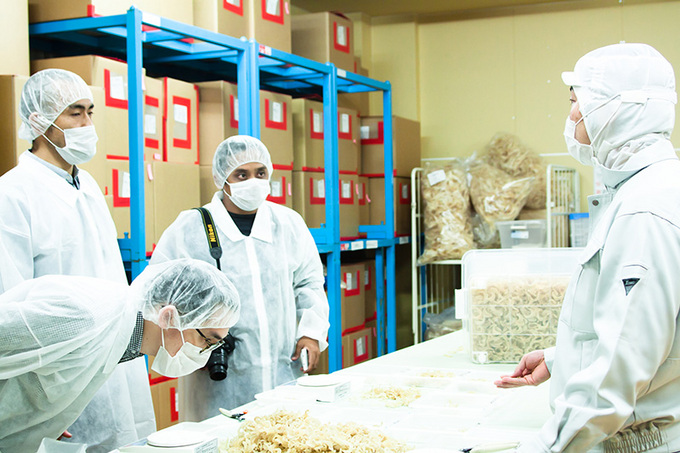
Designers listen to an explanation about the processing process of shark fins at Ishiwata Shoten
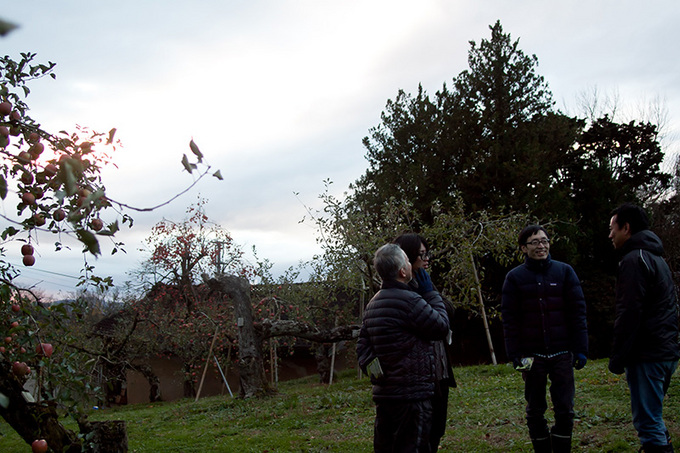
After experiencing apple picking at Three Peaks Winery's apple orchard, designers listened attentively to the orchard owner describe his passions and commitments
Next, for three days in the second half of the program, the participants engaged in the assignment, which was to formulate proposals for communication design in order to market products of the entrepreneurs they worked in their own countries. In an instant, the designers, who until then had assumed a bright and jovial attitude, transformed into serious professionals, and the facility was engulfed by a palpable sense of tension. Some of the designers locked themselves in their rooms skipping meals altogether, while others worked until dawn in the shared working space. Their efforts were inspired by a strong desire to support the efforts of the people they have come to love and respect, to promote their products, and to provide the entrepreneurs, who have kept trying hard in the years since the disaster, with opportunities that will open doors to the world for them.

Left and right: Designers explore ideas for design communication that envision product marketing in their own countries
The purpose of this program was to provide Asian designers with opportunities to explore the role of designers in the context of natural disasters and regional creation. Like Japan, Southeast Asia is a disaster-prone region. As the designers have witnessed tremendous urbanization and decline in the rural areas in their countries, they demonstrated strong interest in the recent trends in Japan, specifically the increasing number of creative initiatives based on the concepts of reconstruction and local creation.
Four and a half years have passed since the Great East Japan Earthquake, and reconstruction activities have made progress in Tohoku. Yet, a vague sense of stagnation is hanging over the region. Many people are exploring a wide variety of measures to counter depopulation, which had been advancing even prior to the disaster, and the continuous curtailment of the local markets. Some are harboring the idea of making an entry into the Asian markets, but they lack clear understanding of the specifics of these markets. They have no idea who their potential customers are, the kind of cities they live in, what they look like, and what their interests are. If the two sides establish concrete and deep relations on a personal level and attain mutual understanding, they will be able to gradually see each other with greater clarity. From this perspective, we aimed to create a program that will establish strong connections not on some abstract regional level, but on a micro level between individuals.
We had the good fortune of welcoming wonderful participants in this program, and the ideas and ways of thinking of the Asian guests and their Japanese entrepreneurs matched very well. As a result, and as demonstrated by the entrepreneur's words mentioned in the beginning of the article, this program exceeded our expectations. I was surprised by the developments set in motion by the program. Less than a month after its end, entrepreneurs who had not considered international expansion, let alone entry into specific Asian markets, went to meet designers in Singapore and Malaysia and discuss future developments. I hope this program creates opportunities to open a "door" that will connect the Tohoku Region and Asia.
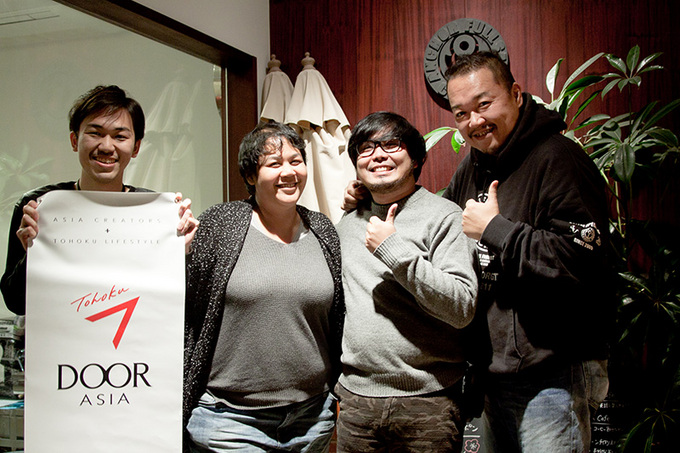
Commemorative photograph of designers who cooperated with Anchor Coffee and representatives of the store chain
Photos:Lyie Nitta
DOOR to ASIA
Participating designers
Zinnia Nizar-Sompie
Ampersand Studio
Cocinero
Adgi
Adityayoga
Inlandaer Design Buro
Jonathan Yuen
Jonathan Yuen
Mali Chaturachinda
be>our>friend studio
Thirada Raungpaka
be>our>friend studio
Dan Matutina
Plus63 Design Co.
Driv Loo
Little Ideas Everyday
Host entrepreneurs
Ishiwata Shoten
Onodera Corporation (Anchor Fullsail Coffee)
Three Peaks
Yagisawa Shoten
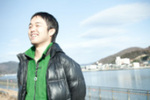 Yuichi Tomohiro
Yuichi Tomohiro
Representative TUMUGIYA/Resource Coordinator
Yuichi Tomohiro was born in 1984 in Osaka. After graduating from Waseda University, he embarked on a journey that led him to more than 70 farming and fishing villages across Japan. After the Great East Japan Earthquake, he launched OCICA, a brand of handcrafted accessories made out of deer antlers by women in Ishinomaki City on the Oshika Peninsula, and is engaged in various media activities.
Back Issues
- 2022.11. 1 Inner Diversity<3> <…
- 2022.9. 5 Report on the India-…
- 2022.6.24 The 48th Japan Found…
- 2022.6. 7 Beyond Disasters - …
- 2021.3.10 Crossing Borders, En…
- 2020.7.17 A Millennium of Japa…
- 2020.3.23 A Historian Interpre…
- 2019.11.19 Dialogue Driven by S…
- 2019.10. 2 The mediators who bu…
- 2019.6.28 A Look Back at J…

